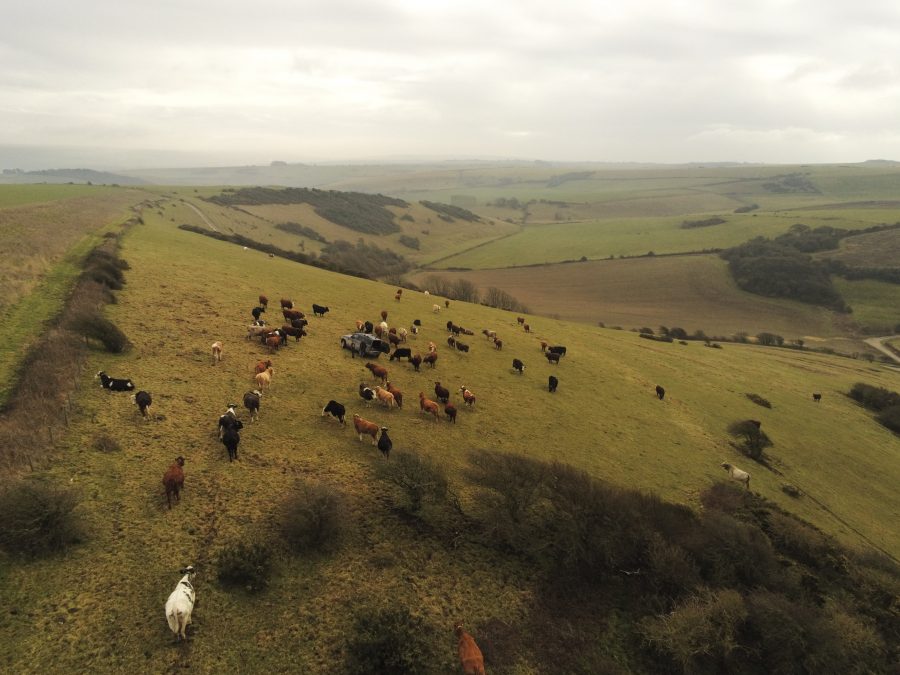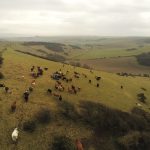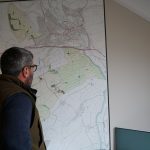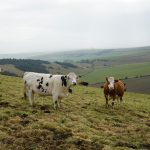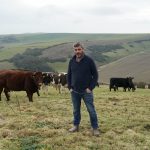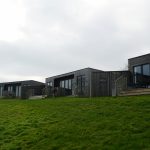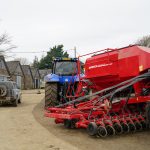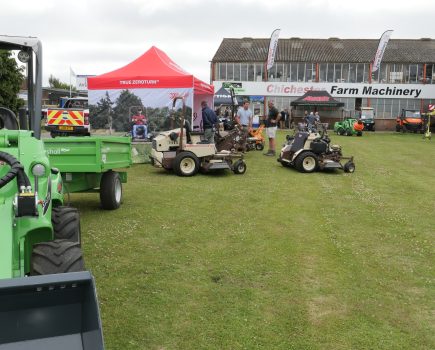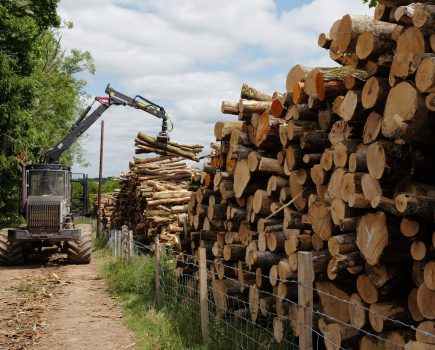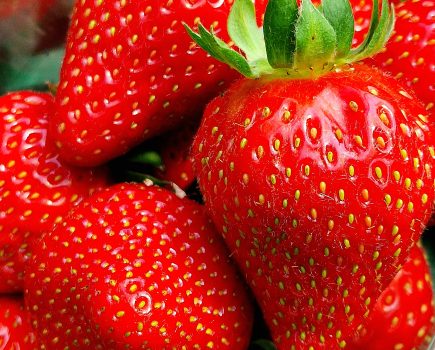This month Nigel Akehurst visits J&H Robinson (Iford Farms) Ltd, a privately owned 1,200 hectare mixed farming business set in the South Downs National Park, near Lewes. He met up with managing director Ben Taylor to find out more about the 30-year estate vision and pioneering work to become a national pilot site for BNG (biodiversity net gain).
Turning off the busy A27 to Brighton onto the winding Kingston and Piddinghoe road, I arrive at the beautiful flint-walled village of Iford, situated at the foot of the South Downs. Arriving at the main Iford farm, I turn down a narrow lane past some grain stores and park up in a lovely old flint courtyard, the location of the modern estate office.
I meet managing director Ben Taylor and owner John Robinson. After a brief chat about The Leaky Buckets (the rock band John plays guitar in) and the new cycle path along the A27 (and their own network of cycle paths at Iford), John has to shoot off and leaves the two of us to chat about the estate and its pioneering biodiversity project.
“I’d like us to be mentioned in the same breath as Knepp or the work that Jake Fiennes is doing at Holkham Estate in Norfolk,” said Ben.
“Iford is becoming one of the places that people are talking about and it’s big enough to do it. We’ve got the vision and we know what we want to do it – it’s just finding the investment to deliver that. BNG will be one route, but there will be other routes as well.”
I learn that BNG stands for biodiversity net gain and is a principle that requires development projects to leave the natural environment in a better state than before. It involves quantifying the value of biodiversity in an area before development and then ensuring that, after development, the value of biodiversity has increased.
The goal is to maintain or enhance ecosystem services and biodiversity, explained Ben, adding that from November it will be a statutory requirement for all development under the Environment Act. At the moment it is quasi-mandatory, he added, with developers beginning to purchase BNG units or think about their pipeline for applications going forwards.
BNG is something Iford has been working on for a number of years. It all stems from a long-term vision and commitment to the landscape, a philosophy that is at the heart of Iford’s estate plan published in 2018.
“It’s the scale of BNG that’s attractive to the authorities and developers,” said Ben.
“It’s designed to make development more palatable; you’ve lost a field here but we’re enhancing the field over there and they’d much rather 1,000 trees were planted in one field than one tree planted in 1,000 fields.
“It’s about landscape-scale restoration and is all part of the vision DEFRA is working towards. There’s not a huge amount of environmental benefit from having one tree in the corner of a field – that’s what stewardship is for,” he said.
“But this whole estate, whole landscape approach is different. When we go up on the hill you’ll see it. We farm the landscape and that’s important for BNG,” he added.
I ask how much one BNG unit is worth.
“It’s a new market, with values varying from £9,000 to £25,000 per unit,” he replied.
It’s also not a decision to be taken lightly, he warned.
“You’re committed to a 30-year term and to delivering the habitat which you’ve said you’ll deliver. If you promise to deliver chalk grassland and it’s not chalk grassland, that’s not okay, so you have to be careful not to be overly ambitious, as these agreements end up on the deeds as a restrictive covenant or section 106,” he said.
The key is your habitat management plan, he explained, where you set out your intended management over the next 30 years.
“You have scope to adjust it because, of course, over 30 years the climate is going to change, but you still have to deliver what you’ve said you’ll deliver,” he said.
Agreements are complex, and as yet no template exists, which means expensive legal agreements involving the developer and the local planning authority (LPA). There is also a lot of preparatory work and upfront consultant fees and ecologist fees, he said, though they have been lucky that DEFRA has helped fund some of it.
To develop these plans Ben has been working closely with Anthony Weston and Harrison Anton from CLM on an ongoing basis, and they are on the phone to each other most days, he added.
In addition to the baseline BNG habitat surveys to identify what areas of existing habitat there are, such as the number of hectares of arable, grasses, scrub etc, the estate has spent the past few years doing a lot of species surveys, bird counts and bio blitzes.
The ecologist Graeme Lyons spent several days on the estate and found thousands of species, often in small pockets, he explained. In time Ben would like to create more of these types of habitat and join them up.
“I would like us to become a little reservoir of biodiversity that can then spread to our neighbours and on into the wider landscape,” he said.
To promote the project the estate has launched a dedicated website at
www.ifordbiodiversityproject.co.uk where there is more information.
Having completed all their habitat surveys and metric calculations, the business is now in a position to offer over 3,000 BNG units in a variety of habitats, said Ben. With their habitat management plans written and final consultations with stakeholders in progress, they already have a number of promising leads with developers in the South East and aim to create an initial habitat bank of 25 hectares of grassland this spring, with further, larger tranches created as demand develops.
I ask Ben if he thinks BNG will replace the income lost from Basic Payments.
Ben thinks it will, but believes it’s important for landowners to consider what the farm’s agricultural output would have been over 30 years and what the opportunity costs are of doing it.
“We struggle to budget the wheat price six months ahead, let alone 30 years. And what other crops might you be growing in 30 years’ time? It could be an 800-hectare vineyard. You have to build into the price the opportunity costs that you forego,” he said.
Another market that is beginning to open up is Environmental and Social Governance (ESG), said Ben. In the same way that corporates have to do their carbon audits, they will also now have to do their biodiversity audits, he explained.
“So rather than selling BNG units, we can sell biodiversity units, which we believe we can measure, using metrics provided by international organisations, and then sell the uplift.”
Ultimately, there’s a lot of appetite from the private sector looking for somewhere to put money. It’s just joining the dots and getting over the line, he said.
One potential pitfall is the tax implications, which HMRC are working their way through. One big question is whether you’re still viewed as farmers or are seen as an asset manager. Ben believes that because they are still managing the delivery of the BNG they are still land managers, although this hasn’t yet been fully tested. He also said there were potential capital gains tax issues, which they are working through.
Farm tour
With my head spinning from a crash course in BNG and keen to get some fresh air, we jump in Ben’s new Defender and head on up the hill to see the farm’s suckler cows grazing. Ben explained that they managed to get Farming in Protected Landscape (FIPL) funding to pay for 140 No Fence collars to enable them to carry out better conservation grazing.
“In the winter we can save on electric fencing and in summer they are on the chalk grassland, where we can concentrate the grazing on the bits that are getting a bit rank and keep them off the flowery bits,” he said.
“Although last year with the drought we were just glad of any grass, so we haven’t properly put that to the test yet,” he added.
With the exception of the odd one crossing the boundary but quickly coming back to its mates, they’ve never had a breakout, he said. This summer they also hope to use the collars to trial some mob grazing down on their brooks.
Ben also pointed to a rough bank, which he said had some nice chalk grassland but is too steep for the cattle. He hopes to use some funding from the Changing Chalk partnership to buy 30 sheep collars to improve the grazing this year.
Arriving at the top of the Downs, Ben points out the boundaries of their land in the far distance.
Since it’s a slightly misty day, I can just about make out the white cliffs at Lewes and the large expanse of low lying brooks (large parts of which are still underwater) in between. It’s an impressive landscape.
History
Heading back down the hill to visit some of their farm diversifications, Ben explained a bit more about the history of the estate, which was founded in 1895 by John’s grandfather Joseph Colgate Robinson, who came from a Quaker family of farmers and millers.
He became a notable breeder of pedigree Dairy Shorthorn and Guernsey cattle and was a pioneer of tubercle-free milk production.
Joseph established a successful retail farm-bottled milk businesses in Hove and in Norbury, South London. The Dairy Shorthorn herd was the largest and best known in the country during the period from the twenties to the fifties and at one time held two world milk production records for any breed.
Over the years he gradually built up the estate, purchasing farms as they became available, and by the Second World War owned all of Iford and Rise Farm and was renting Perching Sands Farm at Fulking and Houndean Farm at Lewes.
He had also set his elder son Harris up independently at Northease Farm. In 1941 the firm of J & H Robinson’ was incorporated as J & H Robinson (Iford Farms) Ltd.
During the war his younger son Henry (HCR) was managing the farm at Perching Sands, but on his marriage in 1944 he moved to Iford to manage the farms for JCR (who had moved to live with his family in Newick in 1922).
In the period after the war there were 50 members of staff growing cereals and producing, bottling and selling milk. A pedigree bull was sold each week around the world and in the Dig for Victory campaign all the land that was ploughable on the hill was sown with cereals.
JCR died in 1962 and HCR continued modernising the farm in an effort to improve productivity and reduce labour costs. He introduced milking parlours at all four Iford dairy herds and drained all the wet marshland, known as the brooks, to grow cereals. He also upgraded from Dairy Shorthorn cattle to higher yielding Red and White Friesian cattle.
His son John (JHR) joined the business in 1970 when there were 35 members of staff. The dairy herds were continually expanded until at one point 650 cows were being milked in five units and they had the largest herd of Red and White Friesians in the country.
HCR retired in 1987, the tenancy at Perching Sands Farm was given up and Houndean Farm was bought. Ben Taylor joined the staff as a student in 1997. Dairy farming became increasingly unprofitable during the latter part of the century and the final herd was sold in 2003.
Ben Taylor became JHR’s assistant manager in 2002 and was appointed managing director in 2008. Swanborough Farm and the business of Greenwood and Son Ltd was bought in 2014.
Farm diversifications
Ben explained that farm diversification is becoming an increasingly important part of the business and an area of expansion in the face of falling farm revenue. Their holiday accommodation site, Swanborough Lakes Luxury Holiday Lodges, has 12 lodges which opened to the public in 2018.
“It’s been a really successful venture ,”said Ben, adding that they had a year-round occupancy rate of 95%. The lodges are high spec, architecturally designed buildings which were designed and built offsite by a firm in Newhaven before being delivered to their landscaped location overlooking fishing lakes (another Iford farm diversification).
Moving on, we stop outside one of their commercial lets – an old flint farm building that has been converted into offices, just one of a number of redundant farm buildings on the estate that has been converted into offices or workshops.
Another more recent farm diversification is a modern livery barn that has recently been completed, offering both DIY and assisted horse livery. Other farm diversifications include a party field for weddings (which is managed by Ben’s wife and friend) and an airstrip which is let out to an aero club.
Regenerative farming
On the farming front, the past few years have seen a move to a more regenerative approach. With rising input costs, they have been focusing their cropping efforts on their very best grade two land, using a no-till drill and cover crops to improve their soil health and reducing their application of fertilisers, pesticides and herbicides.
In the past few years they moved to selling store animals rather than finishing when Ben realised there were people in the midlands who were buying carrot tops or waste bread for next to nothing (often just the cost of the transport) and decided it was better to sell direct to them rather than grow their own silage and maize.
They now sell straight to finishers, depending on their TB status (they are in a TB hotspot but thankfully are clear at the moment). They are also in the process of building up their herd of Sussex cows again as they are better suited to their more extensive grazing system.
In recent years they have also created a modern farmyard with a state-of-the-art grain store and adjacent cattle yards, allowing them to continue to repurpose older barns for diversification.
Ben said a lot of the success of the estate was down to its people. There are four full-time and two part-time staff on the farm side and 16 staff across the estate, covering everything from building maintenance to farm diversifications.
“It’s a fun place to work and I love the variety of the job,” said Ben, who originally studied chemistry before realising he didn’t want to spend his life in a lab and joined the farm as a student. He then took up an assistant manager’s position to John some 25 years ago and the rest, as they say, is history.
The future
Before heading home I ask Ben what his goal is for the future.
“We want to be known as an exemplar landscape scale nature recovery project. That doesn’t mean we are giving up farming.
“Our best land will stay as arable and the rest of it will still be farmed, but the environment becomes the main driver and the grazing of livestock is to facilitate the environmental goal,” he replied.
He paused and then added: “It’s not rewilding, but it’s becoming wilder.”
Farm facts
- 1,200 hectares, almost all owned plus some contract farming
- Farm Castle Hill National Nature Reserve for Natural England
- 800 hectares of arable (conventional rotation of wheat, barley, rye, oats and some peas for Birds Eye)
- Remaining 400 hectares is grass or wasteland of various sorts
- All the grassland is in Countryside Stewardship, some of it for breeding waders, some of it for wintering waders
- 140 cows, with No Fence collars to control grazing
- 12 self catering holiday lodges established in 2018
- Fishing lakes
- Light aircraft strip rented by aero club with 13 aircraft
- Commercial office lets, workshops and storage units in redundant farm buildings plus some houses
- Two commercial shoots
- BNG
- Four full time farm staff and 16 estate staff
- Anafi 1.8.2
- Ben Taylor

